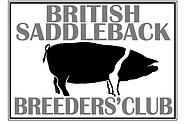The British Saddleback is the result of the amalgamation of two similar breeds, the Essex and Wessex Saddleback.
The origin of the Improved Essex Pig is better authenticated than most. Lord Western, while travelling in Italy, saw some Neapolitan pigs and came to the conclusion that they were just what he needed to improve the breed of Essex pigs. He procured a pair of Neapolitans and crossed them with Essex sows. One of his tenants Fisher Hobbs of Boxted Lodge availed himself of the opportunity to use the Neapolitan-Essex boars belonging to Lord Western and crossed them with his coarse Essex sows and in process of time established the Improved Essex. Sidney in his last edition of Youatt on the Pig, says “The improved Essex probably date their national reputation from the second show of the Royal Agricultural Society, held at Cambridge, in 1840, when a boar and sow, both bred by Mr Hobbs, each obtained first prizes in their respective classes.”
The Essex pig was mainly found in East Anglia. This pig had a black head and neck, as well as a clearly defined belt of white extending over the shoulders and continuing over the forelegs. The rest of the body was black with the exception of white feet and the tip of the tail.
The Wessex originated in the New Forest as a cross between two indigenous old English bacon pigs. By 1914 the breed was also found in the South and South West. It was black all over, asides from a continuous belt of white hair over the forelegs and shoulder. W. J. Walden writing in the 1931 NPBA Gazette explains that stringent rules were put in place by the Wessex Saddleback Pig Society at its foundation to prevent alien blood being brought in where the foundation on one side was not of New Forest origin. The breed prided itself on having resisted the trend to introduce Chinese blood. In his article on Wessex Saddleback markings Walden asks “ Why then make a feature of the chief colouration marking? Surely it does not take a high intelligence to see the correctness and advantage of the one conspicuous trade mark when two China free breeds are brought together?”
The respective breed societies amalgamated in 1918 and the herd books followed suit in 1967 when the British Saddleback breed was established.
The two breeds enjoyed great popularity during the Second World War when 47% of the total pedigree sow registrations were from the Essex and Wessex breed. In 1949 there were 2,435 Essex and Wessex boars licensed representing almost 25% of the licensed boars for that year. The sows retained some of their popularity in the post war years. In 1954 they made up 22% of the total registrations for that year. The boars, however, had lost considerable ground to white breeds and in the same year less than 10% of the licensed boars were from the Essex and Wessex breeds. The recommendations of the time were to cross sows of either breed with a white boar to produce a dual-purpose pig for combined pork and bacon production.
British Saddlebacks are hardy and noted for their mothering ability. The breed continues to be used mainly to provide coloured dams for the production of first-cross porkers, baconers and heavy pigs. The breed is known for its grazing ability and is very hardy. It has secured a niche in outdoor and organic production.
Many Saddlebacks have been exported to Nigeria and the Seychelles where the pigs have performed on coarse grazing in hot climatic conditions
British Saddle Back



